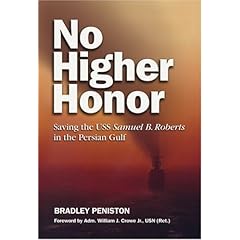Last post discussed the Explosives Handling Personal Qualification/Certification Program (EHPQCP) and how it came to be, as a component of the investigation of the incident aboard the USS SARATOGA (CV-60) in the Med.
Today, some beginning information on the Personnel Qualification System (PQS) and, as I continue, how it played into this incident.
One of my assigned team members, LCDR Don Diehl, wasn’t a big proponent of PQS. While he wore the “water wings” of a Surface Warfare Officer, he has spent much of his career aboard aircraft carriers, being assigned to the USS EISENHOWER (CV-69) in the Operations Department at the time of this assignment. At first, we locked horns many evenings, as we traveled the East Coast and all the way to the Red Sea over the need for this program. He eventually saw my point, as we cut through the standard standard objections fleet sailors like to put forward.
I intend to take the issue of how PQS works up in detail one day soon, as I ended up getting elbow deep in the program in the last half of my career, but the basics of PQS is to validate that training has been held and the knowledge from training retained by the person who will be “qualified” to stand watches of preform various duties aboard ships. In the aviation world, the analogous program is NATOPS. On submarines, they use some PQS, but then have another program in place to validate crew members can perform their duties.
Aboard the USS SARATOGA, the key players in the scenario were:
- Tactical Action Officer (TAO) (Navy Aviator LT (O-3)), Not qualified by PQS
- Ship’s Weapons Coordinator (SWC) (Navy Aviator LT (O-3)), Not qualified by PQS
- Target Acquisition System (TAS) Operator (FC2 (E-5)), Qualified by PQS
- Firing Officer Console (FOC) Operator (FC3 (E-4)), Not qualified by PQS
The TAO did have a letter of designation from the Commanding Officer, an essential piece of paper to allow someone other than the Commanding Officer of a vessel to employ the Ship’s weapons. This position came about during the Vietnam era, when the age of anti-ship cruise missiles rose into a real possibility, reducing reaction times dramatically from the days of gun fights at sea, where you generally had some notice before the first was joined. It is an job of great significance, as it requires a great degree of discretion and sound judgment under conditions requiring split second decision making skills with accuracy.
The path to qualification for the TAO required attending a shore based course (it was six weeks long during my career), where you are first given the “threat matrix,” massive lists of the weapon systems that we were likely to face and their technical capabilities. These were to be memorized, as the information must be readily available when sensors alert you to the inbound weapon, or presence of a threat platform.
Upon return from the school, and usually after some period of “under instruction (UI)” watchstanding, the Commanding Officer would convene a qualification board of the crew experts and you would be grilled on the ship’s specific processes, procedures, current operations orders, rule of engagement (ROE) and your knowledge of the friendly and enemy threat capabilities. If you passed muster, then you were given a letter of qualification, to be filed in your record and annotated on your fitness reports, and allowed to bear the responsibility of the authority to say “SHOOT!” and have people do what you say in a life and death situation.
Were is PQS in this? There was one, the 43304 series. Back then, it was either the B or C edition, but it is now up to the D edition. If it existed, then its use was required. Who says? Well, the Chief of Naval Operations, for one. From OPNAVINST 3500.34F, para. 4.F.:
4.F. PQS use is mandatory, except when suspended or canceled by the lead respective Type Commander (TYCOM). […]
It had that same paragraph for my time in service, therefore, unless Commander, Naval Air Forces Atlantic (COMNAVAIRLANT) had issued a directive to not use the PQS for TAO, it also had to be a part of the path to qualification for the TAO’s aboard SARATOGA. I say SARATOGA, but off all the PQS’ in use, I regularly had arguments with Commanding Officers on surface ships, saying the TAO qualification was up to them, and they didn’t think they needed to use PQS to qualify TAOs. I always figured 4 stars beat any oak leaf or eagle, but that might have just been a pet peeve with me….
There is/was PQS for the Mk-23 TAS Opertator, 43406 series, and also for the MK91 Fire Control/NATO Sea Sparrow Missile System Operators (43328 series). I didn’t regularly work aboard aircraft carriers, and I can’t find a listing for PQS for the Ship’s Weapons Coordinator for a CV Combat Direction Center (CDC), but I suspect it existed.
More later on the PQS issues and the incident….
.JPG)





